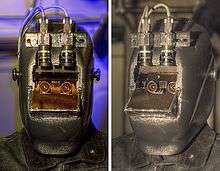High dynamic range
High dynamic range (HDR) is a dynamic range higher than what is considered to be standard dynamic range. The term is often used in discussing display devices, photography, 3D rendering, and sound recording including digital imaging and digital audio production. The term may apply to an analog or digitized signal, or to the means of recording, processing, and reproducing such signals.[1]
Visual
High-dynamic-range imaging (HDRI) is the compositing and tone-mapping of images to extend the dynamic range beyond the native capability of the capturing device.[2][3]
High-dynamic-range video (HDR video) is greater than standard dynamic range (SDR) video which uses a conventional gamma curve.[4]
High-dynamic-range rendering (HDRR) is the real-time rendering and display of virtual environments using a dynamic range of 65,535:1 or higher (used in computer, gaming, and entertainment technology).[5]
On January 4, 2016, the Ultra HD Alliance announced their certification requirements for a HDR display.[6][7] The HDR display must have either a peak brightness of over 1000 cd/m2 and a black level less than 0.05 cd/m2 (a contrast ratio of at least 20,000:1) or a peak brightness of over 540 cd/m2 and a black level less than 0.0005 cd/m2 (a contrast ratio of at least 1,080,000:1).[6][7] The two options allow for different types of HDR displays such as LCD and OLED.[7]
HDR transfer functions that better match the human visual system than a conventional gamma curve include the Hybrid Log-Gamma (HLG) and Perceptual Quantizer (PQ).[4][8][9] HLG and PQ require a bit depth of 10-bits per sample.[4][8]
Audio
XDR (audio) is used to provide higher-quality audio when using microphone sound systems or recording onto cassette tapes.
HDR Audio is a dynamic mixing technique used in EA Digital Illusions CE Frostbite Engine to allow relatively louder sounds to drown out softer sounds.
Dynamic range compression is a set of techniques used in audio recording and communication to put high-dynamic-range material through channels or media of lower dynamic range. Optionally, dynamic range expansion is used to restore the original high dynamic range on playback.
Radio
In radio, high dynamic range is important especially when there are potentially interfering signals. Measures such as spurious-free dynamic range are used to quantify the dynamic range of various system components such as frequency synthesizers. HDR concepts are important in both conventional and software-defined radio design.
Instrumentation
In many fields, instruments need to have a very high dynamic range. For example, in seismology, HDR accelerometers are needed, as in the ICEARRAY instruments.
Realtime HDR vision

In the 1970s and 1980s, Steve Mann invented the Generation-1 and Generation-2 "Digital Eye Glass", as a vision aid to help people see better, with some versions being built into welding helmets for HDR vision [10] [11] [12] [13] See also, IEEE Technology & Society 31(3)[14] and the supplemental material entitled "GlassEyes". [15]
See also
- Rec. 2100 – ITU-R Recommendation for HDR
- Ultra HD Forum – Organization that has created standards for HDR
References
- ↑ Robertson, Mark A.; Borman, Sean; Stevenson, Robert L. (April 2003). "Estimation-theoretic approach to dynamic range enhancement using multiple exposures". Journal of Electronic Imaging. 12 (2): 220, right column, line 26219–228.
The first report of digitally combining multiple pictures of the same scene to improve dynamic range appears to be Mann
- ↑ "Compositing Multiple Pictures of the Same Scene", by Steve Mann, in IS&T's 46th Annual Conference, Cambridge, Massachusetts, May 9–14, 1993
- ↑ Reinhard, Erik; Ward, Greg; Pattanaik, Sumanta; Debevec, Paul (2005). High dynamic range imaging: acquisition, display, and image-based lighting. Amsterdam: Elsevier/Morgan Kaufmann. p. 7. ISBN 978-0-12-585263-0.
Images that store a depiction of the scene in a range of intensities commensurate with the scene are what we call HDR, or "radiance maps". On the other hand, we call images suitable for display with current display technology LDR.
- 1 2 3 T. Borer; A. Cotton. "A "Display Independent" High Dynamic Range Television System" (PDF). BBC. Retrieved 2015-11-01.
- ↑ Simon Green and Cem Cebenoyan (2004). "High Dynamic Range Rendering (on the GeForce 6800)" (PDF). GeForce 6 Series. nVidia. p. 3.
- 1 2 "UHD Alliance Defines Premium Home Entertainment Experience". Business Wire. 2016-01-04. Retrieved 2016-07-24.
- 1 2 3 "What is UHD Alliance Premium Certified?". CNET. 2016-03-11. Retrieved 2016-07-24.
- 1 2 Adam Wilt (2014-02-20). "HPA Tech Retreat 2014 – Day 4". DV Info Net. Retrieved 2014-11-05.
- ↑ Bryant Frazer (2015-06-09). "Colorist Stephen Nakamura on Grading Tomorrowland in HDR". studiodaily. Retrieved 2015-09-21.
- ↑ [http://www.slashgear.com/quantigraphic-camera-promises-hdr-eyesight-from-father-of-ar-12246941/ Quantigraphic camera promises HDR eyesight from Father of AR, by Chris Davies, SlashGear, Sep 12th 2012]
- ↑ Ackerman, Elise (31 Dec 2012). "Why Smart Glasses Might Not Make You Smarter". IEEE Spectrum. Retrieved 1 Jan 2017.
- ↑ Mann, Steve (February 1997). "Wearable Computing: A First Step Toward Personal Imaging". IEEE Computer. 30 (2).
- ↑ A magical welding helmet that lets you see the world in HDR–in real-time
- ↑ Mann, Steve (Fall 2012). "Through the Glass, Lightly". IEEE Technology & Society. 31 (3): 10–14. doi:10.1109/MTS.2012.2216592.
- ↑ "'GlassEyes': The Theory of EyeTap Digital Eye Glass, supplemental material for 'Through the Glass, Lightly'" (PDF). IEEE Technology and Society. 31 (3). Fall 2012.
External links
- "High Dynamic Range (HDR) on Intel Graphics" (PDF). Intel Corporation. November 2017.